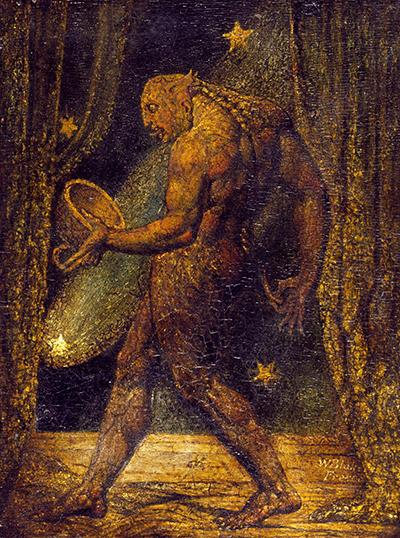The Ghost of a Flea is a miniature painting by the artist William Blake. It measures just 24.1cm x 16.2cm, making it one of Blake’s smallest works. The work is presented on a mahogany hardwood panel.
Blake created the Ghost of a Flea with his signature tempera technique, described in the lower right panel as fresco. The painting is noteworthy for its unusual use of gold leaf. Blake deployed 'white gold' made from a gold and silver alloy for the stars, the flea's flesh and the edge of the curtain. Blake completed the painting between 1819 and 1820. The flea has an almost anthropomorphic quality to it, highlighted by it standing upright on its hind legs. The muscular body of the flea suggests some inspiration from Michelangelo.
The Flea's tongue juts out greedily towards a bowl of blood, drawing on classic satanic imagery. Part human, part animal, and part monster, the flea suggests a humanity tainted by animalistic traits. In the flea's hands it holds an acorn and a thorn, both classic images from fairy iconography. The critic Jonathan Jones has said that the painting contains an implicit critique of portrait art that cannot capture the darker side of human nature.
The painting was one of a series known as Visionary Heads commissioned by John Varley, an astrologist and watercolour painter. Varley was over twenty years younger than Blake and had met him a year before he started the painting. Varley held a deep belief in the existence of spirits that inhabited the earth, however he was deeply frustrated by his inability to see or communicate with them. On the other hand, Blake claimed to have seen visions of spirits regularly since he was a young boy.
Varley and Blake would spend time together attempting to communicate with various spirits. According to Varley, the inspiration for the flea in this painting came to Blake during a séance they held in 1819. Blake told Varley that he saw the apparition of the flea in front of him, so Varley gave him pen and paper to sketch what he had seen. Blake's contemporaries viewed the work of that of a madman, and Blake's claims of seeing visions only reinforced this view. In 2006 the New York Times described it as Blake's "strangest" work. The painting is currently held in the Tate Gallery, London.




